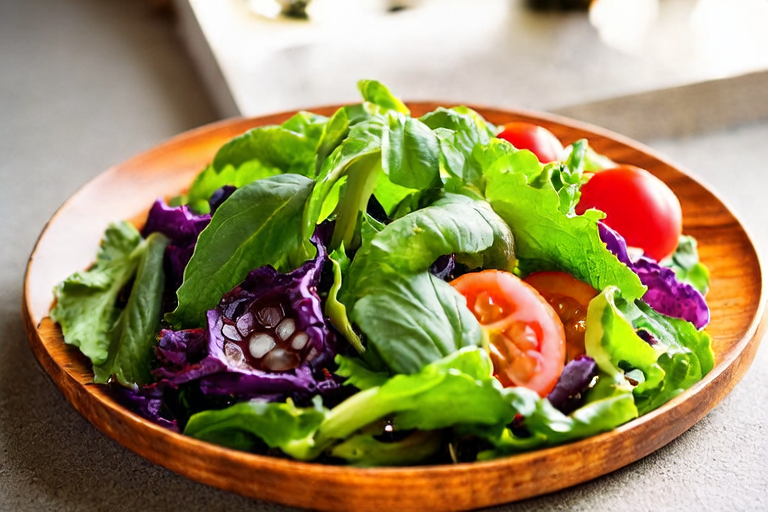- Introduction to Wholesome Greens: A Fresh Salad Symphony
Welcome to the world of culinary artistry where every bite tells a story. In this article, we dive into the vibrant and refreshing realm of salads, specifically focusing on Wholesome Greens: A Fresh Salad Symphony. This symphony is not just a collection of ingredients; it’s an orchestrated blend of flavors, textures, and nutrients that come together in perfect harmony. Salads are more than just a side dish; they are a main course, a celebration of nature’s bounty, and a testament to the versatility of fresh produce.
This guide aims to provide you with everything you need to create a masterpiece of greens that will delight your senses and nourish your body. From selecting the freshest ingredients to mastering the art of dressing and garnishing, each step is carefully crafted to ensure that your salad symphony is nothing short of spectacular.
In the following sections, we’ll explore the importance of choosing the right greens, how to prepare them for optimal freshness, and the various types of dressings that can elevate your salad from ordinary to extraordinary. We’ll also delve into the world of complementary ingredients and garnishes that add depth and complexity to your dish. Finally, we’ll discuss the health benefits of incorporating salads into your diet and offer some creative variations to keep your palate excited.
Choosing the Right Greens
The foundation of any great salad is its greens. The selection of greens is crucial as it sets the stage for the entire dish. Different greens offer unique flavors, textures, and nutritional profiles. Here, we’ll explore the most popular varieties and their characteristics:
- Arugula: Known for its peppery taste, arugula adds a zesty kick to any salad. It pairs well with creamy dressings and sweet fruits like pears or strawberries.
- Mixed Baby Greens: A mix of tender young leaves, these greens are mild in flavor and offer a delicate texture. They are versatile and can be combined with almost any other ingredient.
- Romaine Lettuce: Crisp and crunchy, romaine lettuce provides a satisfying base for heartier salads. Its robust texture holds up well under heavier toppings and dressings.
- Kale: Nutrient-rich and slightly bitter, kale adds a nutritional boost to your salad. It can be massaged with olive oil to soften its texture before adding other ingredients.
- Mizuna: With its delicate, feathery leaves, mizuna offers a mild, slightly spicy flavor. It’s excellent when paired with citrusy dressings or grilled proteins.
When selecting greens, look for crisp, vibrant leaves with no signs of wilting or discoloration. Choose organic options whenever possible to ensure the highest quality and avoid pesticides. For optimal freshness, store your greens in airtight containers lined with paper towels to absorb excess moisture.
Preparing Your Greens for Optimal Freshness
Once you’ve selected your greens, proper preparation is key to ensuring their freshness and enhancing their flavor. Here are some tips for preparing your greens:
- Cleaning: Rinse your greens thoroughly under cold water to remove any dirt or debris. Gently pat them dry with clean kitchen towels or use a salad spinner to remove excess moisture.
- Dressing: Dressing your greens too far in advance can cause them to wilt. Instead, wait until just before serving to drizzle on your chosen dressing. If you’re making a large batch, dress each portion individually to maintain crispness.
- Chopping: Depending on the type of salad you’re creating, you may want to chop your greens differently. For instance, finely chopped arugula can add a finer texture to a mixed green salad, while larger pieces of romaine can provide a more substantial bite.
- Storing: If you’re not using all your greens immediately, store them in airtight containers with paper towels to absorb excess moisture. Keep them refrigerated and consume within a few days for best results.
By following these steps, you can ensure that your greens remain fresh and flavorful throughout the salad-making process.
Dressings: The Heart of the Symphony
A good dressing is the soul of any salad. It ties all the ingredients together, providing balance and enhancing the natural flavors of the greens. There are countless dressing options, but here are some popular choices that complement various types of greens:
- Vinaigrette: A classic choice, vinaigrettes are typically made with a combination of oil and vinegar. Common variations include balsamic, lemon, and Dijon mustard. Vinaigrettes work well with lighter greens like arugula and baby spinach.
- Honey Mustard: Sweet and tangy, honey mustard dressing adds a delightful contrast to peppery greens. It pairs beautifully with grilled chicken or salmon.
- Tahini: Rich and nutty, tahini-based dressings are perfect for those looking for something more substantial. They go particularly well with hearty greens like kale and collard greens.
- Citrus: Citrus dressings, such as orange or lime, add a bright, refreshing element to salads. They complement light greens and fruits like berries or oranges.
- Hoisin: For those who enjoy Asian-inspired flavors, hoisin dressing offers a sweet and savory profile. It works wonderfully with shredded carrots, cucumbers, and bell peppers.
When creating your own dressings, consider the balance of acidity, sweetness, and richness. Experiment with different combinations of oils, vinegars, and seasonings to find the perfect match for your greens. Remember, the dressing should enhance the flavors of the ingredients rather than overpower them.
Complementary Ingredients and Garnishes
To truly elevate your salad, consider adding complementary ingredients and garnishes that add depth and complexity. These elements can range from proteins and grains to nuts, seeds, and cheeses. Here are some ideas:
- Proteins: Grilled chicken, salmon, tofu, or tempeh can add a satisfying protein component to your salad. These ingredients not only enhance the flavor but also increase the nutritional value of the dish.
- Grains: Quinoa, farro, or barley can provide a textural contrast and additional nutrients. They pair well with a variety of greens and dressings.
- Nuts and Seeds: Almonds, walnuts, sunflower seeds, and pumpkin seeds add crunch and healthy fats. They also contribute to the overall nutrition of the salad.
- Fruits: Adding fruits like berries, apples, or pomegranate seeds can bring a touch of sweetness and color to your salad. Fruits complement both light and hearty greens.
- Cheeses: Crumbled feta, goat cheese, or Parmesan can add a creamy, salty element. They work particularly well with bitter greens like arugula or kale.
- Garnishes: Fresh herbs like cilantro, basil, or dill can provide a burst of freshness. Edible flowers like nasturtiums or pansies can add a decorative touch and subtle flavor.
When combining these ingredients, aim for a balance of flavors and textures. Consider the seasonality of your ingredients to ensure they are at their peak freshness. Seasonal produce not only tastes better but also supports local farmers and reduces environmental impact.
Health Benefits of Incorporating Salads into Your Diet
Incorporating salads into your daily routine offers numerous health benefits. Salads are rich in essential vitamins, minerals, and antioxidants, which help support overall health and well-being. Here are some key benefits:
- High in Fiber: Leafy greens are excellent sources of dietary fiber, which aids digestion and promotes regularity. Fiber also helps you feel full longer, making salads a great option for weight management.
- Packed with Antioxidants: Many greens contain high levels of antioxidants, which protect cells from damage caused by free radicals. Antioxidants play a crucial role in preventing chronic diseases and promoting longevity.
- Low in Calories: Salads are generally low in calories, making them an ideal choice for those watching their caloric intake. However, be mindful of the dressings and toppings you choose to avoid adding unnecessary calories.
- Rich in Vitamins and Minerals: Different greens provide various vitamins and minerals, including vitamin K, vitamin C, folate, and potassium. These nutrients are vital for maintaining strong bones, healthy skin, and a robust immune system.
- Sustainable and Environmentally Friendly: Choosing seasonal, locally grown produce reduces the carbon footprint associated with transportation and supports sustainable farming practices.
By making salads a regular part of your diet, you can enjoy a wide range of health benefits while savoring delicious and nutritious meals.
Creative Variations to Keep Your Palate Excited
While the basic structure of a salad remains consistent, there are endless ways to vary your creations. Here are some creative ideas to keep your palate excited:
- Seasonal Salads: Tailor your salads to the seasons. In spring, incorporate fresh peas, radishes, and asparagus. During summer, highlight juicy tomatoes, cucumbers, and corn. Fall brings squash, apples, and pomegranates, while winter features roasted root vegetables and citrus fruits.
- Global Influences: Explore international cuisines for inspiration. Try a Mediterranean-inspired salad with olives, feta, and roasted red peppers. Or venture into Asian flavors with edamame, sesame seeds, and soy sauce.
- Texture Play: Experiment with different textures to create a more engaging eating experience. Combine crispy elements like croutons or fried shallots with creamy components like avocado or cheese. Add chewy ingredients like dried cranberries or chewy grains.
- Colorful Combinations: Use colorful ingredients to create visually appealing salads. Think about contrasting colors like red tomatoes, yellow bell peppers, and green cucumbers. Not only do these combinations look beautiful, but they also ensure a balanced intake of nutrients.
- Themed Salads: Create themed salads based on specific cuisines or occasions. For example, host a Mexican fiesta with black beans, corn, and jalapeños. Or celebrate a special occasion with a luxurious truffle-infused salad.
By embracing creativity and experimentation, you can continue to discover new and exciting salad combinations that keep your dining experience fresh and enjoyable.
Conclusion
Wholesome Greens: A Fresh Salad Symphony is more than just a recipe; it’s an invitation to explore the endless possibilities of fresh produce. By choosing the right greens, preparing them correctly, and pairing them with complementary ingredients and dressings, you can create a salad that is not only delicious but also nourishing. Whether you’re seeking a quick weekday lunch or a show-stopping dinner party dish, salads offer a versatile and satisfying option. Embrace the art of salad-making, and let each bite be a celebration of flavor, texture, and nutrition.
So, roll up your sleeves, gather your ingredients, and get ready to compose your very own salad symphony. Bon appétit!


